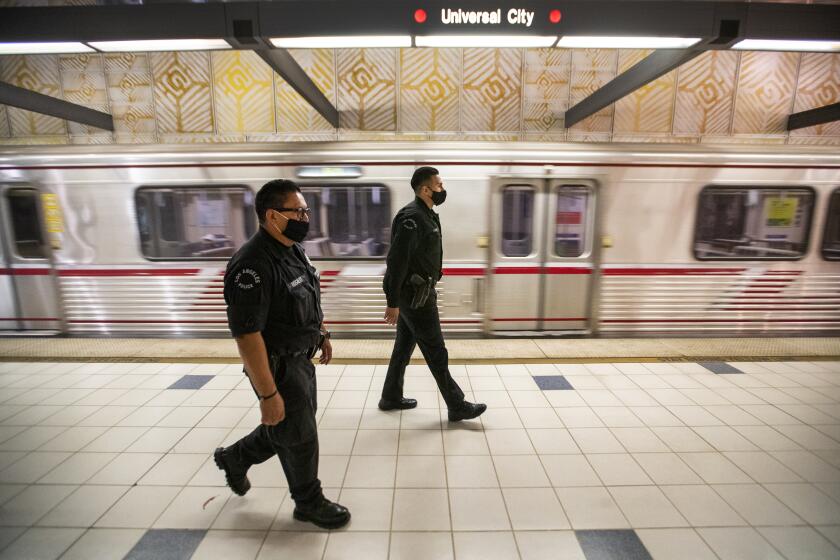Opinion: Metro might create its own police force. Why that won’t make trains and buses safer

Since the program launched last fall, L.A. Metro’s ambassadors — the unarmed “green shirts” who offer riders hospitality, navigation help and connections to social services — have saved more than 70 lives on transit. They did so with CPR, suicide prevention, naloxone to reverse opioid overdoses and other interventions. Among transit riders surveyed, 63% said that they felt safer in the presence of ambassadors. This quantifiable evidence showing success is part of why community advocates like us celebrated when in October, the Metro board voted to transition its ambassadors from a contracted pilot to a permanent in-house program.
But Metro is also exploring another in-house proposal: replacing its ineffective and expensive law enforcement contracts with its own police force, a move the board is set to consider next year. This plan to keep policing at the center of Metro’s safety strategy will undermine both the success of the ambassadors and Metro’s efforts in recent years to improve safety for all riders.
On Thursday, the Metro board unanimously voted to develop a blueprint for a new police agency, a move that could end the longtime contracts with local law enforcement.
The ambassador program reflects efforts to develop a community-based approach to public safety. In response to the 2020 George Floyd protests and movements for Black lives, Metro formed a public safety advisory committee of transit riders, including several members of our coalition, the Alliance for Community Transit-Los Angeles (ACT-LA), to identify solutions to problems they encounter on Metro.
Many of the committee’s recommendations — including the ambassador program — were based on our coalition’s Metro as a Sanctuary vision, which prioritizes riders’ basic human needs through facilities improvements (e.g. bathrooms, shade, lighting, cultural programming and food) as well as services such as mental health outreach, regular cleaning and maintenance, and frequent, reliable and free transit.
The goals of care-based safety are to create environments that ease tension and foster goodwill among riders, increase ridership in a way that reinforces safety, and target root causes of crime and community distrust, namely economic inequality and a lack of resources. The aim is to stop violence before it starts.
Ambassadors are key to this vision as the face of Metro and the first line of support for riders. Many come from the transit-riding communities they represent and have experienced homelessness, incarceration and disability, making them uniquely informed about varied rider needs.
Metro’s budget documents for fiscal year 2024 seem to recognize the need to prioritize nonpolicing approaches, presenting an inverted triangle of public safety with ambassadors, mental health outreach and homelessness services at the top. Yet the current plan invests in contracted law enforcement and armed security at more than four times the rate — more than $200 million — of these care-based safety solutions, which are on track to receive about $45 million.
Disorder, rising crime and declining confidence not only pose an existential crisis to the Metro system but also to the region’s climate, sustainability and livability goals.
Metro is calling the potential in-house force a “transit community safety department,” but that really means doubling down on more of the same, policing.
The agency claims this shift would save money, citing its own study projecting that an internal department would cost perhaps $38 million less than its contracts with the L.A. police and sheriff departments and the Long Beach Police Department. But the estimated $134.5-million cost for in-house policing would still dwarf the budget for the ambassador program and could balloon in the future, as is the trend for police department spending in recent years.
Most crucially, changing the management structure does not fix the fundamental problem with building public safety on transit around police.
Safety on Metro is a real concern (though it’s worth noting the relative safety risk of riding transit is much lower than driving in a car). Many riders, particularly women, report feeling unsafe on the system. As one of the most extensive public spaces in L.A. County, our transit system is also one of the places where our opioid and housing crises are most visible.
COVID, remote work and crime have mass transit in crisis. Los Angeles’ rail system can thrive again with transit-oriented development and housing.
But a Metro police force is not equipped to address those crises. The job of police officers is typically to restrain, cite and arrest people, not to connect an unhoused person, opioid user or a rider without fare to the resources or support services they need. It is not to offer navigation assistance or provide the frequent, reliable service that attracts and keeps riders safe. As for emergencies, municipally operated services — including mental health specialists reached by 988 or 911 — are already available and often more effective than a police response.
For perspective, consider: With the $135 million being considered for in-house officers, Metro could employ more than 2,000 ambassadors — in addition to the around 300 employed now — and give riders more of the unarmed, uniformed presence that they already say makes them feel safer. It could create an expansive network of mental health and homelessness providers available to ambassadors, help deliver millions more hours of bus and rail service or even make possible universal fareless transit, all strategies to enhance ridership.
Instead, Metro is opting to continue an unproductive cycle of policing that disproportionately harms the low-income communities and riders of color who constitute the majority of its core ridership. This distorted perspective of what Metro should offer was on full display when at a recent town hall about its budget, Metro staff touted 1,180 citations, 761 arrests and 17,731 ejections for which the agency was responsible. These numbers shouldn’t be treated as a success but as a failure — they reflect incidents that should have been prevented by the intervention of social services rather than reactively responded to by officers.
Metro should get to community safety with an approach that takes those two words literally: safety via community investment, not a continued focus on policing.
Scarlett De Leon is campaigns director for ACT-LA and a former member of Metro’s Public Safety Advisory committee. Yotala Oszkay Febres-Cordero is applied research specialist for ACT-LA and a Leading Edge fellow with the American Council of Learned Societies.
A cure for the common opinion
Get thought-provoking perspectives with our weekly newsletter.
You may occasionally receive promotional content from the Los Angeles Times.






